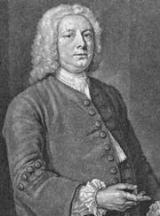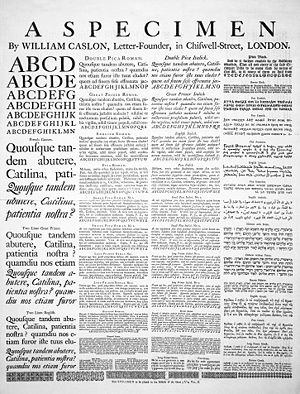
William Caslon
Encyclopedia

England
England is a country that is part of the United Kingdom. It shares land borders with Scotland to the north and Wales to the west; the Irish Sea is to the north west, the Celtic Sea to the south west, with the North Sea to the east and the English Channel to the south separating it from continental...
gunsmith
Gunsmith
A gunsmith is a person who repairs, modifies, designs, or builds firearms. This occupation is different from an armorer. The armorer primarily maintains weapons and limited repairs involving parts replacement and possibly work involving accurization...
and designer of typefaces. He was born at Cradley, Worcestershire
Cradley, Worcestershire
Cradley is a village in the "Black Country" of Dudley, near Halesowen and the banks of the river Stour. It is unofficially known locally as Colley Gate, however Colley Gate is the name of the short road in the centre of Cradley...
, and in 1716 started business in London
London
London is the capital city of :England and the :United Kingdom, the largest metropolitan area in the United Kingdom, and the largest urban zone in the European Union by most measures. Located on the River Thames, London has been a major settlement for two millennia, its history going back to its...
as an engraver of gun locks and barrels, and as a bookbinder's tool cutter. Having contact with printers, he was induced to fit up a type foundry
Type foundry
A type foundry is a company that designs or distributes typefaces. Originally, type foundries manufactured and sold metal and wood typefaces and matrices for line-casting machines like the Linotype and Monotype machines designed to be printed on letterpress printers...
, largely through the encouragement of William Bowyer
William Bowyer
William Bowyer was an English printer.Born in London, he was educated at St John's College, Cambridge, and in 1722 became a partner in his father's business. In 1729 he was appointed printer of the votes of the British House of Commons, and in 1736 printer to the Society of Antiquaries, of which...
. The distinction and legibility of his type secured him the patronage of the leading printers of the day in England
England
England is a country that is part of the United Kingdom. It shares land borders with Scotland to the north and Wales to the west; the Irish Sea is to the north west, the Celtic Sea to the south west, with the North Sea to the east and the English Channel to the south separating it from continental...
and on the continent
Europe
Europe is, by convention, one of the world's seven continents. Comprising the westernmost peninsula of Eurasia, Europe is generally 'divided' from Asia to its east by the watershed divides of the Ural and Caucasus Mountains, the Ural River, the Caspian and Black Seas, and the waterways connecting...
.
Caslon's typefaces were inspired by the Dutch Baroque types, the most commonly used types in England before Caslon's faces. His work influenced John Baskerville
John Baskerville
John Baskerville was an English businessman, in areas including japanning and papier-mâché, but he is best remembered as a printer and typographer.-Life:...
and are thus the progenitors of the typeface classifications Transitional (which includes Baskerville
Baskerville
Baskerville is a transitional serif typeface designed in 1757 by John Baskerville in Birmingham, England. Baskerville is classified as a transitional typeface, positioned between the old style typefaces of William Caslon, and the modern styles of Giambattista Bodoni and Firmin Didot.The...
, Bulmer
Bulmer (typeface)
Bulmer is the name of transitional serif typeface originally designed by William Martin in 1792 for the Shakespeare Press. The types were used for printing the Boydell Shakespeare folio edition....
, and Fairfield
Fairfield (typeface)
Fairfield is an old style serif typeface designed by Rudolf Ruzicka as a text font. Released in 1940, its design is rooted in the forms of Venetian Old Face types. Fairfield Medium was released in 1947....
), and Modern (which includes Bell
Bell (Monotype)
Bell is a Scotch Roman typeface designed in 1788 by Richard Austin. After a short initial period of popularity, the face fell until disuse until it was revived in the 1930s, after which it enjoyed an enduring acceptance as a text face.-Visual Distinctive Characteristics:Characteristics of this...
, Bodoni
Bodoni
-Cold Type versions:As it had been a standard type for many years, Bodoni was widely available in cold type. Alphatype, Autologic, Berthold, Compugraphic, Dymo, Harris, Mergenthaler, MGD Graphic Systems, and Varityper, Hell AG, Monotype, all sold the face under the name ‘’Bodoni, while Graphic...
, Didot
Didot
Didot is the name of a family of French printers, punch-cutters and publishers. Through its achievements and advancements in printing, publishing and typography, the family has lent its name to typographic measurements developed by François-Ambroise Didot and the Didot typeface developed by Firmin...
, and Walbaum).
Caslon typefaces
Caslon
Caslon refers to a number of serif typefaces designed by William Caslon I , and various revivals thereof.Caslon shares the irregularity characteristic of Dutch Baroque types. It is characterized by short ascenders and descenders, bracketed serifs, moderately-high contrast, robust texture, and...
were immediately popular and used for many important printed works, including the first printed version of the United States Declaration of Independence
United States Declaration of Independence
The Declaration of Independence was a statement adopted by the Continental Congress on July 4, 1776, which announced that the thirteen American colonies then at war with Great Britain regarded themselves as independent states, and no longer a part of the British Empire. John Adams put forth a...
. Caslon's types became so popular that the expression about typeface choice, "when in doubt, use Caslon," came about. The Caslon types fell out of favour in the century after his death, but were revived in the 1840s. Several revivals of the Caslon types are widely used today.
The grave of William Caslon is preserved in the churchyard of St Luke Old Street
St Luke Old Street (church)
St Luke is a historic Anglican church building in the London Borough of Islington. It is now a music centre operated by the London Symphony Orchestra and known as LSO St Luke's. It is the home of the LSO's community and music education programme LSO Discovery...
, London.
Caslon Foundry
William Caslon founded the Caslon Foundry at around 1720, which became the leading English typefoundry of the 18th and early 19th centuries.After the death of William Caslon I, his son William Caslon II took over the Caslon Foundry business, which lasted until William Caslon IV sold the foundry to Blake, Garnett & Co. In 1792, William Caslon III sold his share of Caslon Foundry to his mother and his sister-in-law, the widow of his brother Henry. In the same year, William Caslon III purchased the Salisbury Square foundry from the recently deceased Joseph Jackson, and renamed it to Caslon & Son. In 1807, Caslon & Son was passed to William Caslon IV. In 1819, William Caslon IV sold the Caslon & Son to the new Sheffield foundry of Blake, Garnett & Co. In 1837, the Caslon Foundry became the property of Stephenson, Blake & Co. The family of William Caslon III's sister-in-law kept the main Caslon foundry running until 1937, when Stephenson Blake acquired the remaining H.W. Caslon & Sons foundry.

